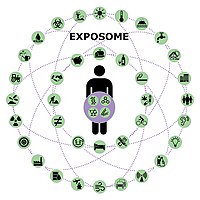
Photo from wikipedia
Background Air pollution contains a mixture of different pollutants from multiple sources. However, the interaction of these pollutants with other environmental exposures, as well as their harmful effects on children… Click to show full abstract
Background Air pollution contains a mixture of different pollutants from multiple sources. However, the interaction of these pollutants with other environmental exposures, as well as their harmful effects on children under five in tropical countries, is not well known. Objective This study aims to characterize the external exposome (ambient and indoor exposures) and its contribution to clinical respiratory and early biological effects in children. Materials and methods A cohort study will be conducted on children under five (n = 500) with a one-year follow-up. Enrolled children will be followed monthly (phone call) and at months 6 and 12 (in person) post-enrolment with upper and lower Acute Respiratory Infections (ARI) examinations, asthma development, asthma control, and genotoxic damage. The asthma diagnosis will be pediatric pulmonologist-based and a standardized protocol will be used. Exposure, effect, and susceptibility biomarkers will be measured on buccal cells samples. For environmental exposures PM2.5 will be sampled, and questionnaires, geographic information, dispersion models and Land Use Regression models for PM2.5 and NO2 will be used. Different statistical methods that include Bayesian and machine learning techniques will be used for the ambient and indoor exposures-and outcomes. This study was approved by the ethics committee at Universidad Pontificia Bolivariana. Expected study outcomes/findings To estimate i) The toxic effect of particulate matter transcending the approach based on pollutant concentration levels; ii) The risk of developing an upper and lower ARI, based on different exposure windows; iii) A baseline of early biological damage in children under five, and describe its progression after a one-year follow-up; and iv) How physical and chemical PM2.5 characteristics influence toxicity and children’s health.
Journal Title: PLOS ONE
Year Published: 2023
Link to full text (if available)
Share on Social Media: Sign Up to like & get
recommendations!